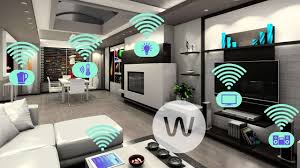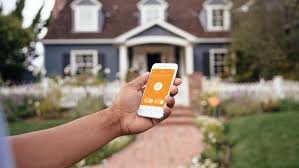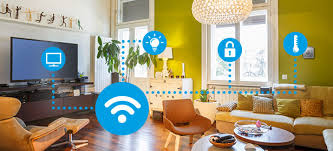Home automation
Home automation:::::::::::
domotics[1] is building computerization for a home, called a brilliant home or shrewd house. A home computerization framework will control lighting, atmosphere, excitement frameworks, and machines. It might likewise incorporate home security, for example, get to control and alert systems.[2] When associated with the Internet, home gadgets are a vital constituent of the Internet of Things.
A home computerization framework normally associates controlled gadgets to a focal center point or "entryway".

The UI for control of the framework utilizes either divider mounted terminals, tablet or personal computers, a cell phone application, or a Web interface, that may likewise be open off-website through the Internet.

While there are numerous contending sellers, there are not very many overall acknowledged industry guidelines and the savvy home space is intensely fragmented.[3] Manufacturers regularly avert free usage by withholding documentation and by litigation.[4] 
The home computerization advertise was worth US$5.77 billion of every 2013, anticipated to achieve a market estimation of US$12.81 billion by the year 2020
History
Early home computerization started with work sparing machines. Independent electric or gas controlled home apparatuses wound up reasonable in the 1900s with the presentation of electric power distribution[6] and prompted the presentation of clothes washers (1904), water radiators (1889), coolers, sewing machines, dishwashers, and garments dryers.
In 1975, the main broadly useful home robotization arrange innovation, X10, was produced. It is a correspondence convention for electronic gadgets. It basically utilizes electric power transmission wiring for flagging and control, where the signs include brief radio recurrence blasts of advanced information, and remains the most generally available.[7] By 1978, X10 items incorporated a 16 channel order support, a light module, and a machine module. Not long after came the divider switch module and the principal X10 clock.
By 2012, in the United States, as indicated by ABI Research, 1.5 million home computerization frameworks were installed.[8]
As indicated by Li et al. (2016) there are three ages of home automation:[9]
Original: remote innovation with intermediary server, e.g. Zigbee computerization;
Second era: counterfeit consciousness controls electrical gadgets, e.g. Amazon Echo;
Third era: robot mate who cooperates with people, e.g. Robot Rovio, Roomba.
"Domotics" (and "domotica" when utilized as a verb) is a withdrawal of the Latin word for a home (domus) and the word robotics.[
Applications and technologies:
Warming, ventilation and aerating and cooling (HVAC): it is conceivable to have remote control of all home vitality screens over the web fusing a straightforward and well disposed client interface.[10][11]
Lighting control framework
Inhabitance mindful control framework: it is conceivable to detect the inhabitance of the home utilizing shrewd meters[12] and ecological sensors like CO2 sensors,[13] which can be coordinated into the building mechanization framework to trigger programmed reactions for vitality productivity and building solace applications.
Apparatus control and reconciliation with the keen lattice and a savvy meter, exploiting, for example, of high sun based board yield amidst the day to run washing machines.[14][15]
Security: a family unit security framework coordinated with a home robotization framework can give extra administrations, for example, remote observation of surveillance cameras over the Internet, or focal locking of all edge entryways and windows.[16]
Break location, smoke and CO detectors[17][18]
Indoor situating frameworks
Home robotization for the elderly and crippled
Pet Care, for instance following the pets developments and controlling access rights[19]
Air quality control. For instance Air Quality Egg is utilized by individuals at hoome to screen the air quality and contamination level in the city and make a contamination delineate
Implementation:
In an audit of home robotization gadgets, Consumer Reports discovered two principle worries for consumers:[21]
A WiFi arrange associated with the web can be defenseless against hacking.
Innovation is still in its early stages, and buyers could put resources into a framework that progresses toward becoming abandonware. In 2014, Google purchased the organization offering the Revolv Hub home computerization framework, coordinated it with Nest and in 2016 close down the servers Revolv Hub relied upon, rendering the equipment useless.[22]
Microsoft Research found in 2011, that home mechanization could include high cost of possession, resoluteness of interconnected gadgets, and poor manageability.[23]
Generally frameworks have been sold as total frameworks where the shopper depends on one seller for the whole framework including the equipment, the interchanges convention, the focal center, and the UI. Be that as it may, there are currently open source programming frameworks which can be utilized with restrictive equipment